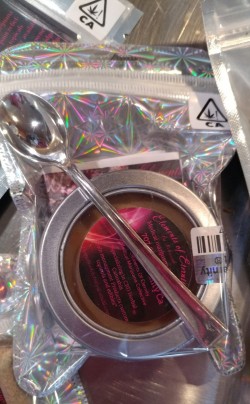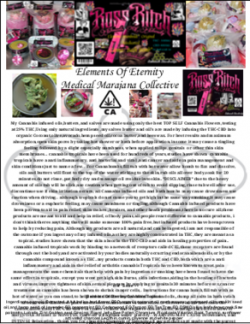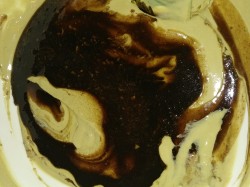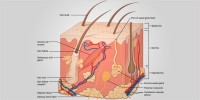THC-CBD Topicals $44 per 2 oz container with lid
Elements of Eternity original formula recipe medicated medical marijuana topical salve,Taking years to perfect this amazing Formula,made with a unique blend of organic oils,i put my heart and sould into every batch,topping each topical with our signature bud flower.. ,pure RSO/THC/CBD oil,herbs and spices Works amazing for all kinds of topical elements such as aches and pains, migraines, excema, acne, bruises,, Burns, skin cancer and much more.My Cannabis infused oils,butters,and salves are made using only the best TOP SELF Cannabis Flowers,testing at 29% THC,Using only natural ingredients ,my salves butter and oil's are made with pure RSO, AND infusing the THC-CBD into organic Coconut,olive,avocado,hemp seed oil,cocoa butter,and beeswax. For best results and maximum absorption,open skin pores by taking hot shower or bath before application,in some it may cause a tingling feeling followed by a slight especially numbness, when applied to lips,genitals or other thin skin membranes... cannabis tropicals have been used for hundreds of years,studies have shown cannabis tropicals have a anti inflammatory, anti bacterial and viral ,anti cancer and aide in pain management and skin conditions just to name a few.. although tropicals do not cause you to get high in the same way smoking,it may cause drowsiness or a euphoric feeling, may cause numbness or tingling,although Cannabis infused products have been proven to aid in pain relief, skin rashes , bruises, and other heath problems,there is no cure all,these products are meant to aid and help in relief, of body pains,all people react different to cannabis products, i don't think theres anything that will make someone 100% pain free,but infused products have been proven to help by reducing pain, Although my products are all natural,and can be ingested,i am not responsible of the outcome if you ingest any of my infused oils,as they are highly concentrated in THC,they are meant as a topical..studies have shown that the skin absorbs the THC-CBD and aids in healing properties of pain.. cannabis infused topicals work by binding to a network of receptors called CB2,these receptors are found through out the body,and are activated by your bodies naturally occurring endocannibendoids,or by the cannabis compound known as THC..my products contain both THC and CBD,both which are a anti inflammatory and aids in the relief of arthritis cannabis Topicals have been known to treat,pain managements the same chemicals that help with pain by ingestion or smoking have been found to have the same effect in topicals, except you wont get high,skin Burns, skin infections,aiding in the healing of bacteria and viruses,improve tightness of skin,sexual pleasure by applying to genitals 30 minutes before sex,cancer treatment as cannabis has been shown to shrink cancer cells,. thank you for choosing Elements of Eternity,all my products are made with the purest ingredients, with the most important ingredient of all LOVE.Rebeccah
*DONT WORRY YOU CAN NOT GET HIGH FROM THC-CBD TOPICALS,BECAUSE IT IS NOT ENTERING THE BLOOD SYSTEM OF THE BODY***
.
Elements of Eternity Medical cannabis Colective
Humboldt C.o
Medicated Cannabis Relaxing pain Relief Salve
Ingerdiants-organic Extracted AAA Indica bud flower,RSO,organic coconut oil,raw beeswax,,grapeseed oil pumpkin seed oil,and hemp seed oil,lavender EO,peppermint EO,Cederwood EO,Tergon EO Tea Tree EO,DSMO,olive leafe,fenugreek,Saw polmetto,Lobelia,Zinc,Golden seal,Ginsing,cinnamon ,Royal Jelly,Bee Pollen,Chromium Picolinate,Valarian Root,Turamic,sunflower Lecithin,cumin,cayenne and white pepper,DMSO
1,643 mg THC 5,840 mg CBD PER 1 OZ
The following information is presented for educational purposes only
Specialized glands, cells, and hairs help the skin perform all of its routine functions. Surprisingly, recent research has shown that cannabinoid receptors are actually found on cells throughout the skin. Cannabinoid receptors are the binding locations for compounds like THC, the primary active chemical in cannabis. Both THC and non-psychoactive CBD are phytocannabinoids. Our bodies make versions of these compounds, known as endocannabinoids.
It’s a common misconception that cannabinoid receptors are concentrated only in the central nervous system and the brain. They’re actually found all throughout the body. This includes the skin, the gut, and reproductive organs. The fact that these cell sites are found in a wide range of bodily regions indicates how important endocannabinoids are to our basic health and physiological functioning. This includes the basic health and functioning of the skin.
What are Topicals?
Topicals are cannabis-infused lotions, balms, and oils that are absorbed through the skin for localized relief of pain, soreness, and inflammation. Because they’re non-psychoactive, topicals are often chosen by patients who want the therapeutic benefits of marijuana without the cerebral euphoria associated with other delivery methods. Other transdermal innovations are fast arriving in the cannabis market, including long-lasting patches and tingly lubricants for patients and recreational consumers alike.
Strain-specific topicals attempt to harness certain terpenes and cannabinoidsin a chemical profile similar to that of Blackberry Kush, Permafrost, Blueberry, or whatever other strains the processor wishes to imitate. Along with THC, CBD, THCA, and other cannabinoids, topical we may also select ingredients and essential oils for additional relief, like cayenne, wintergreen, and clove.
How Do Marijuana-Infused Topicals Work?
Cannabis-infused lotions, salves, oils, sprays, and other transdermal methods of relief work by binding to a network of receptors called CB2. These CB2 receptors are found throughout the body and are activated either by the body’s naturally-occurring endocannabinoids or by cannabis compounds known as “phytocannabinoids” (e.g., THC, CBD).
Even if a topical contains active THC, it still won’t induce that intense “high” you’d get from smoking or ingesting cannabis. With most topicals, cannabinoids can’t breach the bloodstream; they only penetrate to the system of CB2 receptors. Transdermal patches, however, do deliver cannabinoids to the bloodstream and could have psychoactive effects with a high enough THC content.
What Symptoms Do Marijuana-Infused Topicals Treat?
Topicals are most popularly chosen for localized pain relief, muscle soreness, tension, and inflammation, but anecdotal evidence is beginning to show a widening spectrum of potential benefits, from psoriasis, dermatitis, and itching to headaches and cramping.
A THC-rich rub infused with cooling menthol and peppermint is a perfect way to wind down from a brutal workout or hike. For intense localized pain, you may try a warming balm that combines the deep painkilling properties of cannabinoids with a tingling, soothing sensation. Inflammation symptoms may require a different chemical profile
as Cannabis Basics’ CEO Ah Warnerexplains:
“Arthritic pain is caused by inflammation. My products have [THCA] and CBD, both of which are anti-inflammatory. Active THC is not for inflammation, but when left in its acid form and combined with CBD, the two work to get rid of inflammation and the pain that comes with it.”
Different topicals have different benefits to offer depending on the way they are processed and the ingredients that are used, so experiment with various transdermal products to see what works for you. Medical marijuana states are seeing more and more options for topical remedies as time goes on, and for sufferers of pain and inflammation, it’s worth exploring. You’d be surprised the difference that one special ingredient makes.
One of the most effective ways cannabis can be used in therapy and relaxations is topically. Topical cannabis solutions are unique among other forms of cannabis consumption. This is because when cannabis is applied to the skin, it doesn’t break the blood-brain barrier. What does that mean, exactly? It means, simply, that applying cannabis solutions such as salves, balms, and lotions to the skin will not get you high, nor will it be detected in your blood or urine.
The most famous cannabinoid, THC, delivers a psychoactive rush and may euphoria, hunger and drowsiness if consumed orally, sublingually or via smoking or vaporization. However, when applied topically, it doesn’t have that effect at all. In fact, without delivering any psychoactive “high”, THC has been demonstrated to provide significant relief for conditions such as eczema, warts, itchiness, scars, burns, and even arthritis and muscle tension. Topical cannabis salves have even shown to be cell-regenerative and some claim they have helped reduce common symptoms of cancer.
It’s not only THC at work within the cannabis plant though, when applied to the skin. One of the most beneficial components of cannabis is the chlorophyll. That’s right, the green stuff found in all green plants has actually been shown to have a whole bunch of benefits. These range from wound healing and fighting infections to reduce redness and swelling. Cannabis contains an extremely concentrated amount of chlorophyll in relation to many plants, and because of its nontoxic nature, it can be extracted safely and with significant yields.
Before you go running out trying to find the first topical cannabis salve you can find there are a few things to look out for when shopping. You’ll want to ask a few questions to your budtender before purchasing any topical. In general you want to know 3 things:
Were the plants grown for the extract used in the cannabis topical grown without harmful additives that may affect the skin? This is important to ask because though many pesticides and foliar nutrients are approved for the growth of cannabis, some of them may produce a reaction when concentrations are made in contact with the skin.
Was the whole plant used in the extraction, or just concentrated cannabinoids? Basically, you want to know that chlorophyll is contained in the topical. Without it, you will still get the benefits of THC but not the superpower relief that chlorophyll has been demonstrated to deliver.
Last, ask how much cannabinoids by weight are contained in the topical solution. There are many brands out there that advertise “extra strength” but might not contain the appropriate amount of medicinal components to justify that claim. Because there is no psychoactive component to topical cannabis solutions, it is safe to use high concentrations of the cannabis plant to treat severe symptoms.
The components of the cannabis plant that enable it to assuage maladies such as migraines and certain seizure disorders are compounds called cannabinoids, found within its leaves and flowers. The most well-known are tetrahydrocannabinol (THC), which gives weed its psychoactive properties, and cannabidiol (CBD), which is naturally found in higher concentrations in industrial hemp strains. (Marijuana and hemp are variations of the same plant type. The former has been cultivated to have higher THC; the latter, to have more robust stalks—which can be used to make paper, rope, and textiles—and a negligible THC content of less than .3 percent.) The reason these cannabinoids have such profound effects on us—whether ingested or applied topically—is that we are biologically primed to use them.
The human body actually has an endocannabinoid system, through which it produces its own cannabinoids. It's been known since the 1990s that these compounds play a role in regulating functions such as skin sensitivity, appetite, and even memory. (Fun fact: One of the cannabinoids produced in the brain, anandamide, is the same chemical in chocolate that makes us feel euphoric when we consume it.) The two main types of cannabinoid receptors, which are embedded within the membrane of virtually every cell type, are integral to the nervous and immune systems. When we add cannabinoids from plants (similar molecules are also present in chili peppers and echinacea, among others), they can interact with these receptors to help our own endocannabinoid system function more effectively, keeping internal processes, such as those that govern our stress response, stable and balanced. Some of the many issues that have been linked to an out-of-whack endocannabinoid system include neurological disorders, obesity, and high blood pressure.
CBD has no psychoactive properties and, unlike THC, can be sold in all 50 states as long as it's derived specifically from industrial hemp. (THC-laced products can be sold only in states with relaxed cannabis laws and cannot be sent or transported to other parts of the country.) CBD is also considered the most medically active of the two compounds, with research showing that it might help with anxiety and systemic inflammation, as well as mitigate some of the side effects of chemotherapy when taken orally. Applied to the skin, it can diminish localized pain—indeed, the first CBD products to hit the market were designed primarily to target sore muscles and arthritis. Now CBD is turning up in everything from face serums to lip balms, and with mounting studies substantiating its efficacy and versatility, what we're currently seeing may be just the beginning.
"My research group was among the first to investigate whether the skin is capable of producing endocannabinoids, and apparently most, if not all, skin functions are controlled to a certain extent by the local skin endocannabinoid system," says Tamás Bíró, PhD, director of the immunology department at the University of Debrecen, Hungary, and an adviser for Phytecs, a biotech company that researches and develops products targeting the endocannabinoid system for the medical, nutraceutical, and cosmetic industries. "This includes the skin barrier, which is very important for moisture retention, sebum production, and sweat-gland function, as well as skincentric sensory functions such as pain and itch. But perhaps most important, it appears that the endocannabinoid system controls skin inflammation—so if an inflammatory or irritation challenge assaults the skin, the endocannabinoid system fights against it." This could potentially make cannabinoids useful antiaging ingredients, and, Bíró speculates, due to their capacity to regulate sebum, they might turn out to be especially potent tools for fighting acne, although studies are still in the preclinical stages: "We found that when we applied CBD to human skin cells in a Petri dish," he says, "it prevented the inflammation and high production of sebum" associated with breakouts.
"Cannabinoids haven't really emerged in mainstream dermatology," says Adam Friedman, MD, associate professor of dermatology at George Washington University, who is currently developing methods for nanoparticle delivery of CBD through the skin. "But I think that's going to change. Given that there is a wide array of skin conditions notorious for chronic inflammation and debilitating itch or pain, there are numerous potential applications. There's going to be an exponential increase in the attention paid to this in the derm world."
At this early stage, there are still some questions about how topical cannabinoids should be formulated and dosed. While CBD has emerged as the star player in most lotions and potions currently cropping up from niche brands across the country, evidence does suggest that its effects can be boosted by combining it with other active molecules from the cannabis plant, including THC and/or terpenes, the phytochemicals that give pot its distinctive aroma. (This phenomenon, known as the entourage effect, was first recognized by Raphael Mechoulam, PhD, the Israeli organic chemist who identified the presence of THC and CBD in cannabis in the 1960s.) Many brands—such as Whoopi Goldberg's Whoopi & Maya line, which was created to relieve period pain, and Los Angeles–based luxury brand Lord Jones, whose chicly packaged, edible THC–laced gummies and chocolates are Instagram gold—are formulated with both CBD and THC. Other brands, targeting states with stricter antimarijuana laws, stick with straight-up CBD that has been extracted in a way that retains many other naturally occurring (but legal) molecules, such as terpenes and flavonoids. (And some brands do both, such as Colorado-based Apothecanna, which creates two versions of each of its products, one with THC and one without, to suit different markets.) But even in small doses, CBD alone appears to be beneficial. "Because the skin has its own endocannabinoid system, just the superficial application of CBD by itself is extremely helpful," says Raj Gupta, chief scientific officer of Colorado Springs–based Folium Biosciences, a company that produces ultrapremium, THC-free, phytocannabinoid-rich hemp oil. "CBD is an antioxidant, so you can see changes in skin pattern, such as a reduction in hyperpigmentation."
In order to ensure that the product you're using contains high-quality cannabinoids, the best bet is to buy from a brand sold at a medical dispensary or trusted retailer. Also, don't worry that the creams, even those containing THC, are going to make you feel high. "Topical preparations have insignificant systemic absorption and are not known to cause psychoactive effects," says anesthesiologist Debra Kimless, MD, who specializes in cannabis and pain management and serves as medical director for ForwardGro, a medical-cannabis cultivating and research company based in Maryland. "Some patients claim that they feel relaxed, usually because they are experiencing pain relief." Kimless does caution, however, that while no studies have tested topical THC's ability to make it into the bloodstream, "there is always a chance" that it could show up in a drug test.
Although cannabis has been used both medicinally and recreationally for thousands of years—and was a primary ingredient in some mainstream pharmaceuticals in the early 1900s—it has been largely unstudied in the United States since 1937's Marihuana Tax Act, which effectively banned its use and sale. That's all changing, albeit slowly, as the stigma of conducting clinical tests involving an illegal drug fades away. Still, says Friedman, we have a long way to go before the cannabis plant, which contains scores more yet-unstudied cannabinoids beyond CBD and THC, is fully understood—not to mention the full effects each of those individual cannabinoids have when applied to skin. "It's such a cool field, but so much of the information we have is still limited and early on," he says. "There are probably a lot more questions than answers at this point, but I think we're going to see a lot more research coming down the pike."












